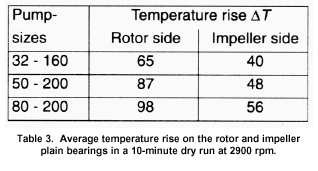Experience with SAFEGLIDE
After the introduction of SAFEGLIDE-coated plain bearings for the magnetic drive pumps of the MNK and MNK-B series the statistics of the users showed that pump damage caused by improper operation, which resulted in dry running, fell dramatically within a very short time.
After the initial excellent results with coated plain bearings, the range of operating conditions was increasingly extended. The pumps were now also used for media with a permanently high solids content and for low-boiling products near the evaporation point. Modes of opera-tion, e.g. pumping containers completely empty, monitored by the dry-run signal became possible with the new plain bearings. Expensive monitoring facilities, such as filling level display, could be dispensed with. Instead, low-cost motor load monitors were and still are fre-quently used in conjunction with ?SAFEGLIDE.?
Studies on the plain bearings used demonstrated that the coating is still fully functional even after prolonged service in highly corrosive media.
One example of this excellent result is the plain bearing system of an MNK 32-160 shown in Figure 4 which was in operation for roughly 40,000 hours. Moreover, one problematic aspect was that the product crystallized out and the sliding surfaces of the bearings were thus contaminated with crystalline solids. The examination of the sliding surfaces showed that the coating was intact even after this lengthy period of operation.
Refinement of SAFEGLIDE to SAFEGLIDE PLUS
The design and production process of the plain bearings have been further optimized in recent years. The parameters of the coating process were also improved, which means that today a very uniform,defect-free SAFEGLIDE coating can be manufactured in large series. Dry-running tests were continuously conducted with these plain bearings, which are optimal for magnetic drive pumps.
It is very difficult to reliably observe the temperature which is produced on the sliding surfaces during dry running. The temperature must remain so low that the surrounding plastic-lined components are not damaged.
Moreover, the pump user must bear in mind that high temperatures occur with prolonged dry running. If the suction valve is suddenly opened after dry running, the product which is to be conveyed and which also flows through the plain bearings is heated. This can cause undesirable reactions with sensitive products.
The situation becomes even more critical when an explosive mixture is in the pump during dry running or the medium to be conveyed has a low ignition temperature. In this case it is very important to limit the dry running time to a few minutes, e.g. by using appropriate monitor-ing facilities like a motor load monitor.

"SAFEGLIDE PLUS"
The entire tribosystem was examined and optimized in a 2-year research project. Different layer variations based on the SAFEGLIDE were manufactured and tested. The latest coating processes, e.g. the so-called ?multi-layer coating process,? were also included in the stud-ies. However, the use of soft graphite layers was intentionally omitted in order to guarantee a long-life coating and thus the capability to repeatedly run dry.
In addition, various details of the bearing mount were changed in order to eliminate the negative effects of the temperature rise during dry running.
All the optimization aspects relating to the bearing situation of the magnetic drive pumps of this manufacturer are being launched onto the market as the SAFEGLIDE PLUS.
This optimized bearing system repeatedly produced the temperature curves shown in Figure 4 for the impeller and rotor plain bearings dur-ing dry-running tests. The result shows that it is possible to let mag-netic drive pumps with SAFEGLIDE PLUS plain bearings run dry for over 75 minutes. This outstanding result was repeatedly confirmed in many tests and on pumps of various sizes.
Further test series were conducted in order to check whether the layer properties are changed after such a long dry-running period. In these tests the plain bearings which had previously been subjected to a dry run of 75 minutes were used. Then the same bearings were operated 19 times with a dry run of 10 minutes and the temperature rise was measured on the plain bearings (table 3).



